#oedipus and antigone
Explore tagged Tumblr posts
Text

José Ribelles y Helip (Spanish, 1778-1835) Antigone and Oedipus, n.d. Real Academia de Bellas Artes de San Fernando
#José Ribelles y Helip#spanish art#rome#neoclassical#Theban princess#spanish#western civilization#1700s#art#fine art#european art#classical art#europe#european#oil painting#fine arts#europa#mediterranean#hispanic#latin#artwork#spanish neoclassical#painting#oedipus and antigone#oedipus#antigone#mythological art#neoclassical art#neoclassicism#1800s
35 notes
·
View notes
Text
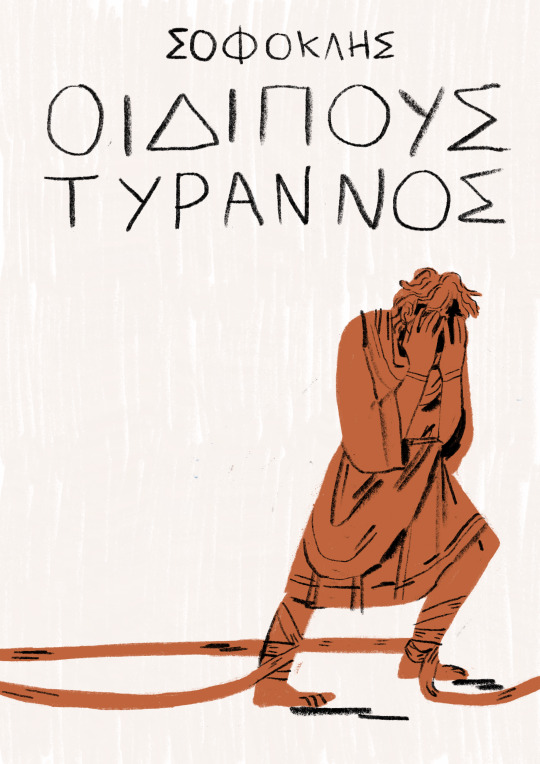
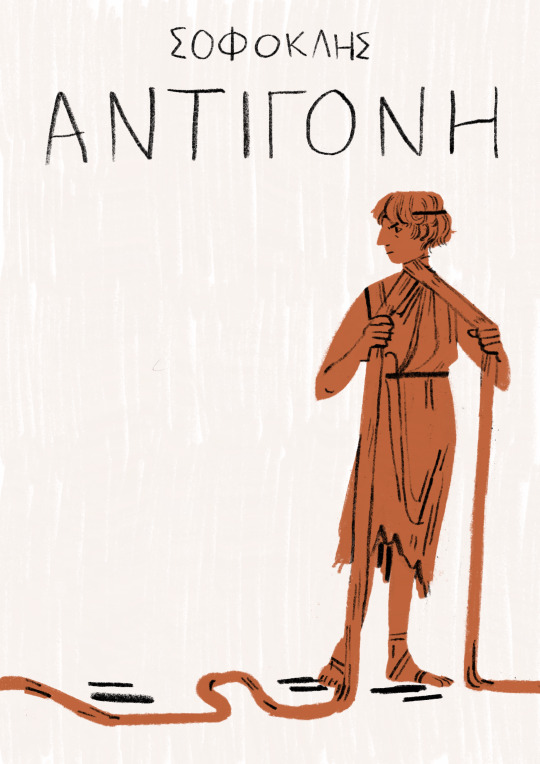
like father like daughter
1K notes
·
View notes
Text

Oedipus and Antigone, Franz Dietrich (1838-1890)
#art#art history#Franz Dietrich#classical mythology#Greek mythology#mythological painting#Oedipus#Antigone#German art#19th century art#oil on canvas#Crocker Art Museum
249 notes
·
View notes
Text









Rhaenyra’s Hubris, 2x07
"If ever mortal man require how you were put to shame and blinded, tell him Odysseus, raider of cities, took your eye" (Homer 503)
Sophocles “Oedipus the King” | “Antigone” / Homer “Odyssey”
#rhaenyra as an epic hero and a tragic hero too#i'm so excited to see her dark era in s3#rhaenyra targaryen#hubris#web weaving#hotd#house of the dragon#hotd season 2#hotd s2#house of the dragon season 2#house targaryen#hotd meta#welighttheway#hotddaily#greenqueenhightower#the red sowing#hotd s2 ep7#hotd s2 e7#team green#the greens#team black#the blacks#hotd edit#comparatives#sophocles#antigone#creon#oedipus#oedipus rex#asoiaf
173 notes
·
View notes
Text

#it's so interesting that antigone too is compared to a tool#her father's tool -- his prothesis and therefore a part of himself#daddy's blunt little instrument#*lit#antigone#oedipus at colonus
130 notes
·
View notes
Text
keep thinking now about the idea of the ancient greek stage building as a doorway into death, which is separated from the stage (the space of the living) by the screen of the skene. cassandra calls it as much ("the gates of hades") when she enters the house of atreus. by convention characters cannot die on stage but must exit, usually into the skene, to be killed. cassandra's just extra explicit about it because of her foresight, but every entry into the stage building is a step into death. and then some people come back out of it!!!
#polymestor goes with his sons into death but then is dragged back...#killers like clytemnestra and orestes take their victims into death and leave them there#the origin point of these thoughts is actually oedipus at colonus#but VERY much hecuba and all three electra plays and the classic sophoclean *she exits silently into the house to kill herself*#also the way phaedra and hippolytus invert each other in death and directionality#it'd be interesting to do antigone with a setting switch during the choral ode where she does her own lament#so that the skene becomes the cave where she's imprisoned and then turns back into the palace for the last scene#mine#bodycostume#sorta. i think stage space plays into this somehow
384 notes
·
View notes
Text








Older male recluse invades a pseudo-household and wreaks havoc against the mother and her child by catalyzing their sexual awakening through carnal manipulation in a volatile and repressed orthodox environment
89 notes
·
View notes
Note
Another tragic woman that im pretty sure Noone ever talks about is Ismene, daughter of Oedipus. Like, Girl lost everyone, both her brothers, her mother, her father, and how much she tried not to lose Antigone as well, but lost.
Yeah… I think she lost her lover too, girl can’t catch a break.
20 notes
·
View notes
Text

first look — phia saban with lesley manville and mark strong in rehearsals for oedipus west end.
#house of the dragon#hotd#tv shows#queen helaena targaryen#helaena targaryen#phia saban#antigone#oedipus#theater#cast#bts#behind the scenes#robert icke#rehearsal room
53 notes
·
View notes
Text
The Strange Things with the Thebans...
I promised you guys that I'll make an essay about it so let's get it started.
Chapter I: Cadmus & The Dragon

One of the greatest heroes before Heracles alongside Perseus and Bellerophon, Cadmus is the mythological founder king of Thebes. One interesting fact about him is that, despite of being considered a greek hero, Cadmus wasn't even greek in the first place. In fact he was phoencian and came from a city called Tyre. By ancient standards he would've been considered a "barbarian". Another irony is that Cadmus' initial purpose wasn't even to become a king, but to rescue his sister Europa, at that time kidnapped by Zeus in the shape of a bull. A further irony: Europe was named after an asian princess. Aaand another further irony: when the modern state of Hellas/Greece joined the European single currency, and so abandoned the drachma of old, it celebrated its accession and new monetary union by striking a coin bearing the image of Zeus disguised as a bull in the act of abducting (a polite way of masking the actual fact of rape) Europa.
Anyway, back to Cadmus: Once arrived in Boetia he intended to sacrifice a cow to Athena and asked his men to fetch water from the river. There was one single, little, tiny, itsy-bitsy problem though: the said river was guarded by the Ismenian Dragon, who also happened to be Ares' son. So Cadmus, just like any other hero, slayed the dragon and, listening to Athena's advice, planted the serpent's teeth. Out of these teeth a bunch of dudes grew up and started to fight (and consequently kill) each other, with the exception of five who survived: Echion, Udaeus, Chthonius, Hyperenor, and Pelor, who are now considered the ancestors of thebans. (Okay, the question now would be with whom they reproduced, but that's an ask even I don't want to know the answer to...).
Pseudo-Apollodorus, Bibliotheca 3. 22 (trans. Aldrich) (Greek mythographer C2nd A.D.) : "[Kadmos (Cadmus)] sent some of his men to fetch water from the spring of Ares, but a Serpent, said by many to be a child of Ares, guarded the spring and destroyed most of those who had been sent. In outrage Kadmos killed the Serpent, and then, following the instructions of Athena, planted its teeth. From this sowing there sprang from the earth armed men, called Spartoi (Sparti). These proceeded to kill each other, some in voluntary encounters, and others in ignorance. Pherelydes says that when Kadmos saw the armed men growing up from the earth, he threw stones at them, and they, believing that they were being hit by each other, started their fight... As for Kadmos, to atone for the deaths he served Ares as a laborer for an 'everlasting' year, for a year then was equal to eight years now."
Cadmus was punished for slaying the dragon by serving Ares for a certain period of time. Later, Athena assigned to him the government of Thebes and Zeus gave him Harmonia as his wife. Found another irony: Harmonia was the daughter of Ares, which makes him and Cadmus in-laws. Irony number five million: despite of being married with the personification of harmony herself, Cadmus' family tree is characterized by an entire disharmony. According to Statius, Harmonia received from Hephaestus a cursed necklace that brought unluck, which later got passed from one generation to another:
Statius, Thebaid 2. 265 ff (trans. Mozley) (Roman epic C1st A.D.) : "The dread necklace of Harmonia... The Lemnian [Hephaistos], so they of old believed, long time distressed at Mars' [Ares'] deceit and seeing that no punishment gave hindrance to the disclosed armour, and the avenging chains removed not the offence [of his affair with Hephaistos' then wife Aphrodite], wrought this [a cursed necklace] for Harmonia on her bridal day to be the glory of her dower [description of the necklace follows]... The work first proved its worth, when Harmonia's complaints turned to dreadful hissing, and she bore company to grovelling Cadmus, and with long trailing breast drew furrows in the Illyrian fields [the pair were turned into serpents in Illyria]. Next, scarce had shameless Semele [their daughter] put the hurtful gift about her neck, when lying Juno [Hera] crossed her threshold. Thou too, unhappy Jocasta, didst, as they say, possess the beauteous, baleful thing, and didst deck thy countenance with its praise - on what a couch, alas! to find favour; and many more beside. Last Argia shines in the splendour of the gift, and in pride of ornament and accursed gold surpassed her sister's mean attiring. The wife of the doomed prophet [Eriphyle wife of Amphiaraus] beheld it, and at every shrine and banquet in secret cherished fierce jealousy, if only it might be granted her to possess the terrible jewel, nought profited, alas!"
Cadmus and Harmonia left Thebes after a series of catastrophes which happened in their family and emmigrated to Illyria where they battled various local tribes to found a new kingdom. Eventually, they two got turned into snakes and carried off to the Elysium to live a peaceful life.
Pseudo-Apollodorus, Bibliotheca 3. 39 : "Kadmos (Cadmus) and Harmonia left Thebes and went to the Enkhelean (Enchelean) people. They were being harassed by the Illyrians, and learned from the god through an oracle that they would overpower the Illyrians if they had Kadmos and Harmonia as their leaders. Trusting this, they made these two their leaders in the campaign, and did indeed defeat the Illyrians. Kadmos ruled the Illyrians, and fathered a son named Illyrios, Later on, both he and Harmonia were turned into serpents, and were sent by Zeus out to the Elysian field."
Chapter 2: Semele Thyone

Semele: the youngest daughter of Cadmus and Harmonia and mother of Dionysus, and the theban princess infamously known for her not-so-bright intellectual capabilities.
Zeus slept with Semele and left her pregnant. Later, Hera payed her a visit disguised as her nurse and told her to ask Zeus to come to her in the same way he's coming to his wife (gotta admit, I didn't expect Hera to be this horny...). Later, Semele got killed by Zeus for her mistake, and Zeus managed to rescue the fetus she was carrying in her womb and let it develop inside his thigh.
Pseudo-Apollodorus, Bibliotheca 3. 26-27 (trans. Aldrich) (Greek mythographer C2nd A.D.) : "Zeus fell in love with Semele and slept with her, promising her anything she wanted, and keeping it all from Hera. But Semele was deceived by Hera into asking her to come to her as he came to Hera during their courtship. So Zeus, unable to refuse her, arrived in her bridal chamber in a chariot with lightning flashes and thunder, and sent a thunderbolt at her. Semele died of fright, and Zeus grabbed from the fire her sixth-month aborted baby, which he sewed into his thigh. After Semele's death the remaining daughters of Kadmos (Cadmus) circulated the story that she had slept with a mortal, thereafter accusing Zeus, and because of this had been killed by a thunderbolt."
Pseudo-Hyginus, Fabulae 179 : "Jove [Zeus] desired to lie with Semele, and when Juno [Hera] found out, she changed her form to that of the nurse Beroe, came to Semele, and suggested that she ask Jove to come to her as he came to Juno, ‘that you may know,’ she said, ‘what pleasure it is to lie with a god.’ And so Semele asked Jove [Zeus] to come to her in this way. Her request was granted, and Jove, coming with lightning and thunder, burned Semele to death. From her womb Liber [Dionysos] was born. Mercury [Hermes] snatched him from the fire and gave him to Nysus to be reared. In Greek he is called Dionysus."
Years later Dionysus rescued her from the Underworld. She was made immortal and received the name Thyone:
Pseudo-Apollodorus, Bibliotheca 3. 38 (trans. Aldrich) (Greek mythographer C2nd A.D.) : "He [Dionysos] retrieved his mother [Semele] from Haides' realm, gave her the name Thyone, and escorted her up to the sky."
Chapter 3: The Bacchae

"He is life's liberating force. He is release of limbs and communion through dance. He is laughter, and music in flutes. He is repose from all cares -- he is sleep! When his blood bursts from the grape and flows across tables laid in his honor to fuse with our blood, he gently, gradually, wraps us in shadows of ivy-cool sleep."
Thebes was closely associated with a particular shape-shifting, cross-dressing, gender-bending deity: Dionysus. Despite the fact that Thebes worshipped Dionysus even ahead of Apollo, according to Euripides' Bacchae his first visit to Thebes didn't go very well. Tragedy. Madness. Homocide. Maternal felicide. Dismemberment. Decapitation. Suicide ensued. Word Abuse.
Dionysus returns to Thebes followed by the Maenads in order to clear his mother's name and punish the thebans for not worshipping him. He disguises himself as a mortal and induces madness in all the women of Thebes, who flee to Mount Kytheron to celebrate rituals in honor of the god. Dionysus' aunts, Semele's sisters Ino, Autonoe, and Agave, are also charmed into becoming members of the Dionysian cult. In the court of the Theban palace, Cadmus and his advisor, Tiresias, prepare to join the Maenads. They are stopped by the arrival of the king of the city, Pentheus, back from his travels in Thebes. Son of Agave and Echíon, Pentheus is enraged by the condition of the Thebans and orders the immediate capture of Dionysus.
The king's messengers return bringing the god. Pentheus comes out of the palace and questions the young leader of the debauchery. Dionysus presents himself as a believer of the son of Zeus, inviting the king to join the rite. In response, Pentheus orders his confinement in a stable. The chorus mourns the prisoner, but is a few moments later the palace is engulfed in flames, and collapsed by a strong earthquake.
Dionysus emerges unscathed from the wreckage and is reunited with his maenads. Pentheus receives news from a messenger, who informs him about the situation of the maenads in the forests. They nurse wolf cubs, cast spells, and are possessed of unimaginable strength, which they use in killing herds of cows and bulls, and in attacking villages. Dionysus, still in disguise, convinces the king to abandon his plan of punishing the women by brute force. He advises him to spy on them first by dressing up as a maenad and pretending to be part of the group. Pentheus is slowly hypnotized by the god's influence and approves of the plan.
A messenger arrives to report that once the party reached the mountain, Pentheus wanted to climb a tree to get a better view, and the stranger used divine power to bend the tree and place the king in its highest branches. Dionysus revealed himself, summoned his followers and sued the intruder. The maddened maenads, led by Agave, brought Pentheus down from the tree, tore off his limbs and head, and tore his body to pieces.
Agave arrives home, carrying her son's bloody head. In her state of divine bliss, she thinks she holds the head of a mountain lion. She proudly shows it to her father, Cadmus, and is confused by his horrified expression. Agave calls Pentheus to come and marvel as well. Then the madness begins to fade, and Cadmus forces her to admit that she killed her own son. At the end of the play Pentheus' corpse is reassembled, Agave and her sisters are sent into exile, and Dionysus decrees that his grandparents, Cadmus and Harmonia, will be turned into serpents.
Chapter 4: Actaeon & his Hounds

Actaeon, son of Autonoe and Aristaeus as well as a theban prince and skillful hunter, is known for a) either intentionally or accidentally seeing Artemis bathing and b) getting turned into a deer and then flayed by his hounds. Was it worth it, Actaeon? Was it?!
Pseudo-Apollodorus, Bibliotheca 3. 30 (trans. Aldrich) (Greek mythographer C2nd A.D.) :
"To Autonoe and Aristaios was born a son Aktaion, who was reared by Kheiron and trained as a huntsman, but was later eaten up on Kithairon by his own dogs [because] . . . he saw Artemis bathing. They say that the goddess changed him on the spot into a deer, and drove his fifty hunting dogs into a frenzy so that they unintentionally ate him. When he was no more, they looked for their master with great howls and bays, coming in the course of their search to Kheiron's cave. He made a likeness of Aktaion, which assuaged their grief."
Chapter 5: Leucothea & Palaemon

Ino married Athamas and gave birth to two sons, Learchus and Melicertes. After Hera found out they accepted to take care of infant Dionysus she inflicted both of them with madness. Athamas slew Learchus, whereas Ino grabbed Melicertes and leapt off a cliff into the sea. They were later welcomed by the sea gods and received the names Leucothea and Palaemon.
Pseudo-Apollodorus, Bibliotheca 3. 28 : "Zeus... gave birth to Dionysos, whom he entrusted to Hermes. Hermes took him to Ino and Athamas, and persuaded them to bring him up as a girl. Incensed, Hera inflicted madness on them, so that Athamas stalked and slew his elder son Learkhos (Learchus) on the conviction that he was a dear, while Ino threw Melikertes (Melicertes) into a basin of boiling water, and then, carrying both the basin and the corpse of the boy, she jumped to the bottom of the sea. Now she is called Leukothea (Leucothea), and her son is Palaimon (Palaemon): these names they receive from those who sail, for they help sailors beset by storms."
Chapter 6: The Sphinx
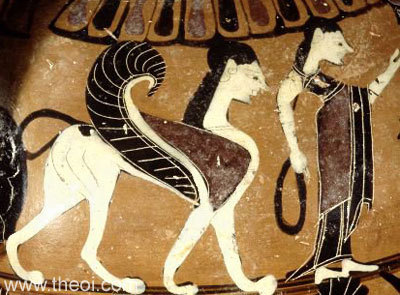
The Sphinx was a woman-headed winged lion infamously known for asking people the same riddle (and eventually turning them into dinner for giving her the wrong answer): "What is it that has one voice, and is four-footed and two-footed and three-footed?"
The origins of the Sphinx and the reason why she was sent to plague Thebes differ from one from one source to another. According to Pseudo-Apollodorus Hera sent her to Boetia as a punishment towards the Thebans for not having Lains punished, who had carried off Chrysippus from Pisa:
Pseudo-Apollodorus, Bibliotheca 3. 52 - 55 (trans. Aldrich) (Greek mythographer C2nd A.D.) : "While he [Kreon (Creon)] was king, quite a scourge held Thebes in suppression, for Hera sent upon them the Sphinx, whose parents were Ekhidna (Echidna) and Typhon. She had a woman's face, the breast, feet, and tail of a lion, and bird wings. She had learned a riddle form the Mousai (Muses), and now sat on Mount Phikion (Phicium) where she kept challenging the Thebans with it.
According to a Scholia on Hesiod's Theogony though it was Dionysus who sent her, whereas according to Euripides' Phoenicians she was either sent by Ares as a punishment for Cadmus, by Hades, or she was in fact one of Cadmus' daughters who was thrown into madness and went through a metamorphosis. Luckily it looked more like one of Ovid's Metamorphoses rather than Kafka's Metamorphosis, though after she started to eat people she certainly became a parasite. *badum tss*
Anyway, what is certain though is that she went through an existential crisis and killed herself after Oedipus managed to respond correctly to her riddle.
Chapter 7: Oedipus Rex

"And as for this marriage with your mother— have no fear. Many a man before you, in his dreams, has shared his mother’s bed. Take such things for shadows, nothing at all— Live, Oedipus, as if there’s no tomorrow."
Cadmus and Harmonia's only son, Polydorus, had a son named Labdacus who had a son named Laius who had a son named Oedipus; also known as the original motherfu-
The most famous myth version of Oedipus is the play Oedipus Rex or Oedipus Tyrannos, written by Sophocles.
The tragedy begins with the turmoil of the city of Thebes, which was facing a torment: the plants, animals and women were barren, and the plague made countless victims. The Thebans cane to ask Oedipus, the king of Thebes for help, who also got rid of the Sphinx by answering the Sphinx's riddle correctly. Creon, Oedipus' brother-in-law, is sent to the oracle to find out why this misfortune has befallen Thebes. The oracle reasons that the death of Laius, Oedipus' predecessor, has not been atoned for. In order to find out who killed Laius, Oedipus requests to be asked Tiresias, the old blind prophet. Tiresias tells Oedipus that he is the murderer of Laius. Believing that Tiresias and Creon have plotted against him, Oedipus argues with them. His wife, Jocasta, with whom he has four children, two boys - Eteocles and Polynices - and two girls, Antigone and Ismene, reassures him by telling him that Laios has been foretold that he will be killed by his own son, whom they gave for adoption in another country to avoid this tragedy. At that moment, Oedipus remembers the reason why he came to Thebes: to get away from his family so as not to kill his father, as he was told at birth. At a crossroad, Oedipus had a conflict with a group of robbers, thus killing his father, disguised as not to be recognized as the king. Oedipus then suffers a nervous breakdown, gouging out his own eyes since he believed that they are the ones that caused him not to see the truth.
Chapter 8: Seven Against Thebes
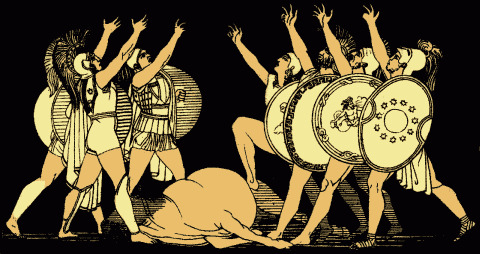
Another tragic episode from Thebes was the myth of the seven heroes who made war on this city, after the king of Argos chose them as captains of an army whose purpose was to restore Oedipus' son Polynices to the Theban throne. The myth is recounted in the play with the same name written by Aeschylus.
Seven Against Thebes opens with Eteocles calling forth every man in the city, whether child or aged, to the fight and the threat, which is at hand. Everyone must be ready to defend the city in battle. At that moment, the Scout enters with news that the enemy is just outside the walls and is preparing for battle. There are seven commanders ready to attack the seven gates of Thebes. After delivering the news, the Scout departs, and Eteocles prays to Zeus for his favor in the battle to come. The Chorus, which has entered as the Scout has related his news, begins a lament as they hear the approach of the armies. They beg their gods to protect them and their city. Eteocles hears the Chorus’ fearful pleadings as he enters and chastises them for their fear, which he says will not help their beloved Thebes. Instead, Eteocles promises that the Chorus will be stoned to death for their mindless fear, as their fear will incite the city’s residents into an instinctive fear of their own, which will disable and defeat the city. But the Chorus is not appeased, and they continue with their warnings as Eteocles warns them of the risk they create with their wailing. Eteocles again warns the Chorus to remain inside and to hold back their panic. At their continued warnings and fearful exclamations, Eteocles responds with attacks on the nature of women, their weaknesses, and their fears. Finally the Chorus promises to restrain their fear and remain silent, and Eteocles again prays to the gods, with promises of sacrifices and trophies if Thebes is successfully defended. After Eteocles leaves the stage, the Chorus continues to voice their worry at the coming battle and the risk they face if they are taken and become slaves.

When the Scout enters, he brings news of who will lead the attack at each of the city’s gates. At the news of each opponent’s assignment, Eteocles assigns one of his men to defend that particular gate. When Eteocles is told that his brother, Polyneices, will lead the attack on the seventh gate, Eteocles decides that he will defend that gate. At this news, the Chorus warns Eteocles that he should not shed his brother’s blood, but Eteocles is beyond listening to warnings. He acknowledges the curse of his father, Oedipus, but Eteocles says that fate will determine the outcome, and if the gods are determined that he shall be destroyed, then this will happen. The chorus is dismayed at Eteocles departure and cry out that if each bother slays the other, there will be no family to see to a proper burial. The Chorus then begins to remind the audience of the story of Oedipus and the curse that followed his father, himself, and now his sons. At that moment, the Scout again enters with the news that Thebes has crushed her enemy, and the city is victorious. Six of the seven gates have withstood the onslaught of the enemy’s armies, but the battle at the seventh gate has ended in tragedy. Both Eteocles and Polyneices are dead, each at the others hand. The Scout reminds the Chorus that the city must mourn the death but also celebrate the end of the curse. The Chorus asks is they should mourn these deaths or celebrate the triumph of Thebes’ victory. With the arrival of the brother’s bodies, the Chorus acknowledges the tragedy that has unfolded. The bodies are followed closely by Ismene and Antigone, who have come to bury their brothers. The Chorus addresses the sisters, with grief and with sadness at the resolution of the curse. The two sisters respond to the Chorus with their own grief, as they lament the curse that damned both brothers. As Antigone wonders where they will bury the brothers, a Herald enters with an announcement that the council has met. The council has determined that Eteocles is a hero and will be accorded an honorable burial. However, Polyneices would have laid waste to Thebes, and thus, his corpse is to lie unburied, to be picked apart by the birds of prey. Antigone promises that she will bury her brother, as she will not be bound by the Theban council’s ruling. A brief argument with the Herald ensues, but Antigone will not be threatened, and finally, the Herald leaves to report to the council. The play ends with the Chorus divided. Half will accompany Eteocles to his grave; half will accompany Polyneices to his burial.
Aeschylus' Seven Against Thebes was part of a trilogy, along with other two tragic plays called Laius and Oedipus. Unfortunately both of them got lost, along with a comedic play titled The Sphinx. Due to the popularity of Sophocles' Antigone the ending was rewritten about half of a century after Aeschylus' death so that play could have a less mournful tone and turn Antigone into a continuation of it.
Chapter 9: Antigone

Similarly with Oedipus Rex, the tragic play Antigone written by Sophocles is one of the most precious literary creations of antiquity. Antigone, the brave daughter of Oedipus, witnesses the disaster caused by the fight between her brothers, Eteocles and Polynices. Both fell in battle, and the throne of Thebes is occupied by Creon. The king orders the funeral of Eteocles, the defender of the fortress, to be organized with pomp. For the other son of Oedipus though, Polynices even a simple burial is prohibited. Antigone, the sister of the two fighters, stood up against the harsh royal order, facing the danger of the death penalty. In great secrecy, she surrenders the body of Polynices to the earth, thus fulfilling the obligation that, according to custom, the blood connection with the dead man demands.
Antigone's deed was quickly discovered by Creon who sentences her to death. However, she is fearless in the face of death, viewing it as a release from suffering. In the heated discussion between Creon and Antigone, a sharp clash of moral principles is revealed. Antigone, the frail and tender maiden, is endowed with a bold character, with a courage worthy of a fighter. Her strength to face the king is derived from the conscience that acts in the name of the ancient, unwritten laws, which summarize the traditional morality, deeply rooted in the Greek cities. Antigone will perish in prison, but Creon, who disregarded the will of the gods, will receive a severe punishment by losing his son, Haemon (Antigone's fiance), and his wife, who commits suicide by cursing her proud and reckless husband.
Final Note
It took me waaay longer than I intitially expected to make this thing. The fact that I forgot at one point about this post didn't help either. I've also considered including the myth of the Coronides as well, but I've already talked about it many times on this blog so I decided to end it with Antigone. I'm also aware of the fact that there are different versions of the exact same myth, as well as I might have accidentally included mistakes here and there. Also also, I realized that if I don't insert any humor I'll die out of boredom while making this, hence the dry jokes. Anyway, hope you'll like it! 👍
#greek mythology#greek gods#thebes#cadmus#semele#dionysus#pentheus#sphinx#oedipus#antigone#ramblings
20 notes
·
View notes
Text

Oedipus and Antigone
Artist: Christoffer Wilhelm Eckersberg (Danish, 1783–1853)
Genre: Mythological Art
Date: 1812
Media: Oil on Canvas
Collection: The National Museum in Stockholm
Description
In this painting of Oedipus and Antigone from 1812, Eckersberg presents a doting and concerned Antigone and an elderly Oedipus who is visibly very frail. Oedipus nonetheless shoulders the burden of carrying some heavy clothing on his back, while Antigone walks more freely, albeit while expending energy tending to her father. I love the bright colours in this scene, but also the way Eckersberg manages to capture the melancholy of both characters and the tenderness between them. On they go, in sadness, across the bridge.
In Greek mythology Antigone is a Theban princess and a character in several ancient Greek tragedies. She is the daughter of Oedipus, king of Thebes; her mother is either Jocasta or, in another variation of the myth, Euryganeia. She is a sister of Polynices, Eteocles, and Ismene. The meaning of the name is, as in the case of the masculine equivalent Antigonus, "in place of one's parents" or "worthy of one's parents".
#greek mythology#mythological painting#mythological art#oedipus#antigone#19th century painting#19th century art#landscape#danish painter#princess#trees#suspension bridge#rocks#water stream#elderly man#father and daughter
47 notes
·
View notes
Text


spent an evening with a greek tragedy <3
#lesley manville STOLE THE SHOW#just have to put that out there#phia was ofc fantastic i want to see her in the antigone solo play so baaaad#oedipus#jocasta#antigone#phia saban#lesley manville#mark strong#m rambles#actor tag
24 notes
·
View notes
Text
obsessively thinking about antigone tonight. queer antigone / antigone as a product of incest displaying incestuous undertones&themes herself / married through death antigone (anouilh’s antigone, who wanted to have her first time with hemon the evening before she goes to bury her brother, who wanted to die not-a-virgin and yet not-a-wife but who didn’t, because they fought instead) / antigone who only knows how to live for oedipus / antigone who only knows how to die for her brothers / antigone who is nothing but her love for her family / antigone who leaves ismene behind / antigone who knows her brothers have been cursed by her father but still goes back to thebes, because she has to / antigone who knows creon will remove the dirt she puts on polyneikes’ body, but still puts it there, because she has to / antigone ready to die, born to die / antigone already dead from the beginning, her fate sealed long ago / antigone leaving thebes as a child knowing she will only come back to die.
#antigone#it’s probably my favorite tragedy#which says a lot because i love many ancient tragedies#but antigone ?#i love her so much#i have so many versions of her story now#plays : sophocles (3 translations including one by anne carson) / anouilh / cocteau#novels : henry bauchau’s oedipus on the road + antigone#and it breaks me every single time#classics#oedipus#jocasta#ismene#eteokles#polyneikes#polynices
109 notes
·
View notes
Text

My greek mythology shelf! I have more place, so i need more greek plays (its easy maths)
#mithology#greek mythology#greek myth#odyssey#iliad#the odyssey#the iliad#tsoa#the song of achilles#antigone#oedipus#agamemnon#ive read more than this. but it was from school😭
26 notes
·
View notes
Text
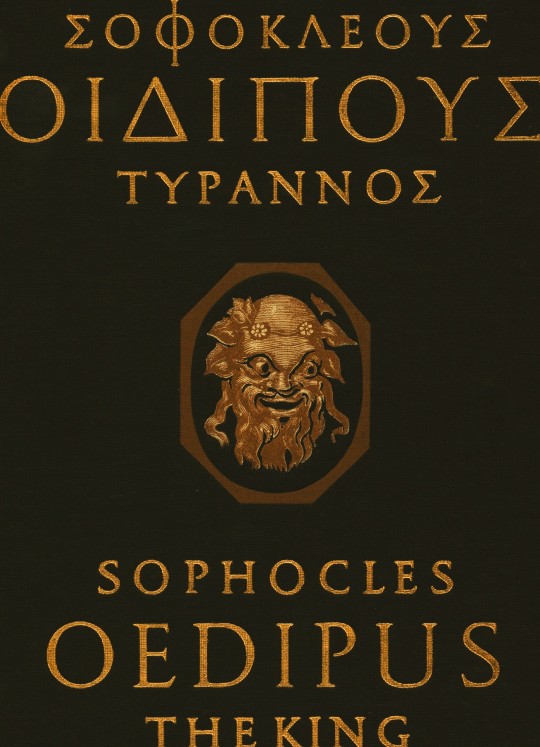
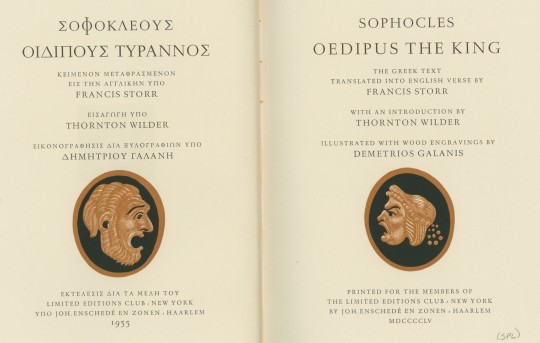
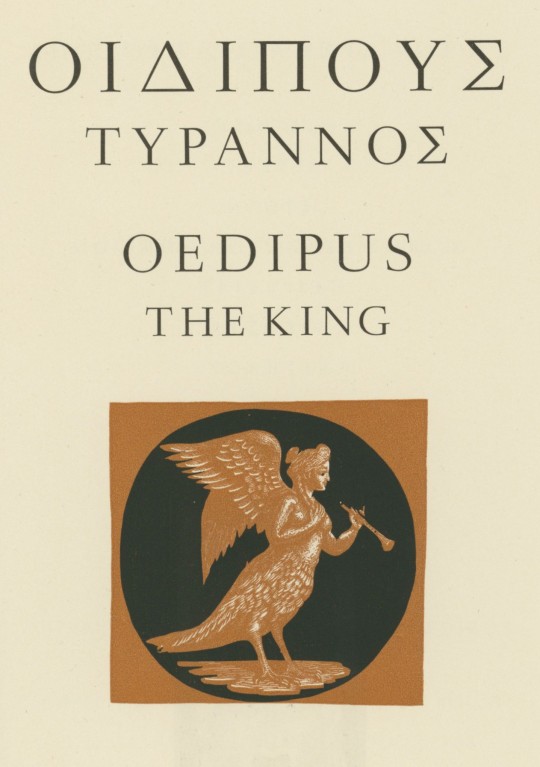


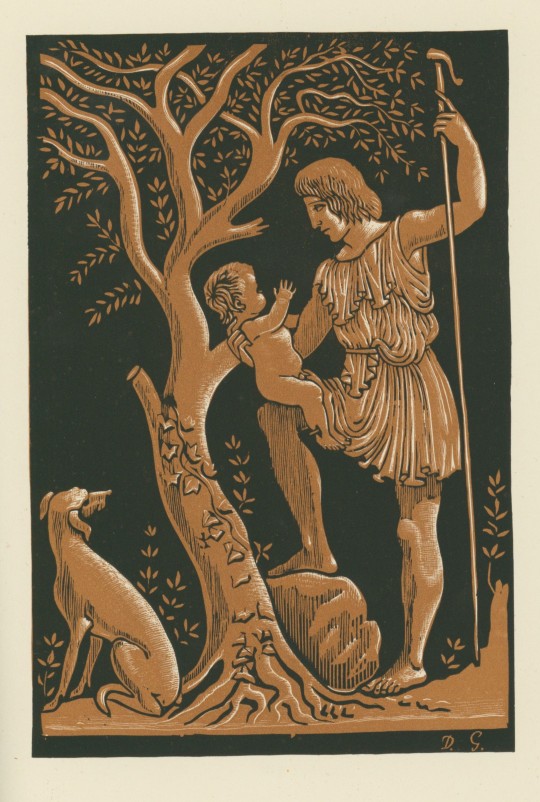
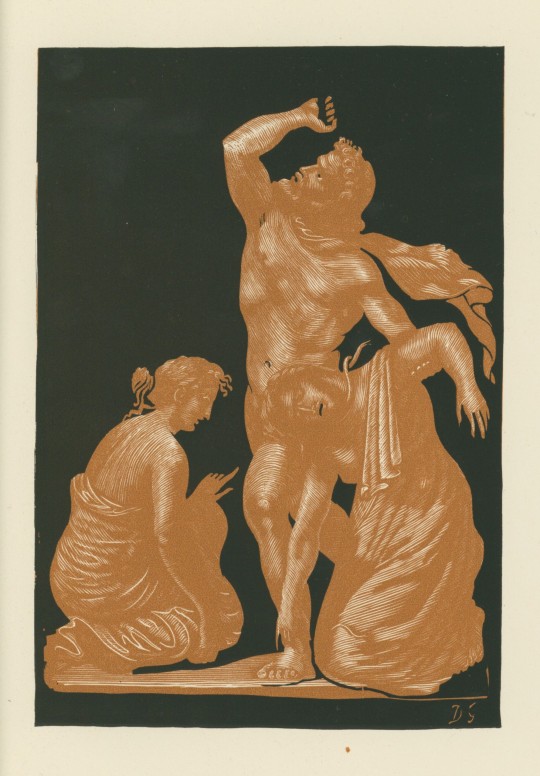

Tragically Greek
This 1955 edition of Oedipus the King, written by Sophocles, features the original Greek text alongside the English verse translation. Offering a rich, immersive reading experience results from hard work, dedication, and creative minds coming together to create this masterpiece.
Jan van Krimpen (1892-1958), Dutch typographer, book designer, and type designer, designed the two typefaces. The Greek type is named “Antigone,” and the English type is called “Romulus.” The translator for this work was Francis Storr (1839-1919), a British classicist, translator, and teacher.
The paper was specially manufactured at the historic Dutch Pannekoek Papermill, a mill with a rich history that unfortunately met its end in a fire in 1944. This exclusive feature adds a touch of rarity to your reading experience. Printed in the offices of Johannes Enschedé, under the supervision of Mijnheer van Krimpen, it was for the members of the Limited Editions Club.
Adding to the richness of this edition is the detailed and insightful introduction provided by Pulitzer Prize winner Thornton Wilder (1897-1975), American playwright, novelist, and native of Madison, WI. His esteemed perspective offers an enlightening preface to the classic tale.
The illustrations are black and terra-cotta wood engravings designed by Greek artist Demetrios Galanis (1879-1966). He was the trailblazer of modern Greek engraving and was once touted as one of the greatest living Greek artists at the time of the book’s release.
Sophocles (c. 497/496 – winter 406/405 BC) was an ancient Greek playwright born in Colonus near Athens. He is one of the three great tragedians of classical Athens, along with Aeschylus and Euripides. Sophocles wrote over 120 plays during his lifetime, although only seven have survived in their entirety. His works are characterized by their complex characters, well-crafted plots, and profound exploration of moral and philosophical themes.
Among his most famous plays is the tragedy Oedipus the King. The story is about Oedipus, the king of Thebes, who tries to uncover the truth behind a plague that has struck his city. In doing so, he discovers that he himself is responsible for the plague, having unknowingly killed his father and married his mother. The play delves into themes of fate, free will, and the consequences of one's actions.
-Melissa, Special Collections Classics Intern
View other Classics posts
#classics#sophocles#oedipus#oedipus rex#oedipus the king#greek mythology#greek#wood engraving#athens#tragedy#greek tragedy#ancient greece#oedipus complex#Limited Editions Club#Johannes Enschedé#Enschedé#Jan van Krimpen#Antigone type#Romulus type#Francis Storr#Demetrios Galanis#Pannekoek paper#LEC#Thornton Wilder#Melissa
62 notes
·
View notes
Text

Oedipus at Colonus, tr. Robert Fitzgerald
81 notes
·
View notes